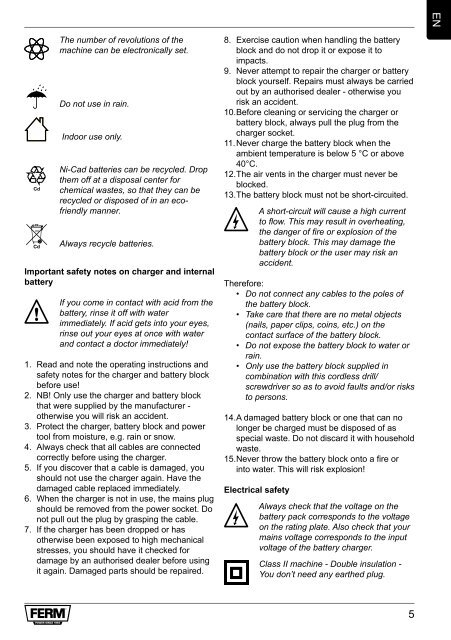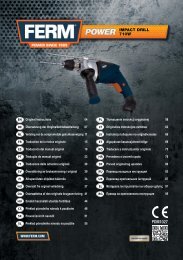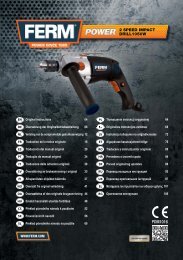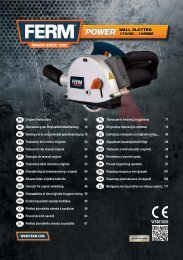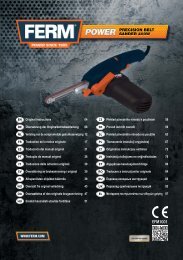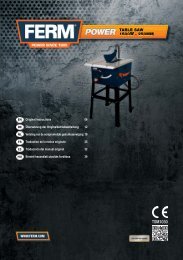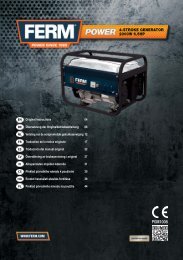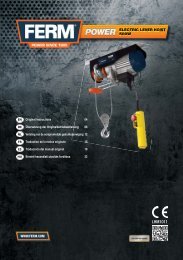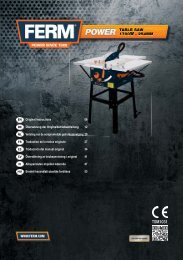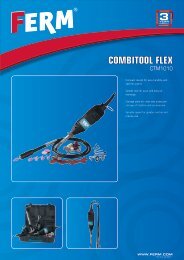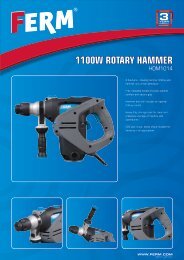CDM1104 - FERM.com
CDM1104 - FERM.com
CDM1104 - FERM.com
You also want an ePaper? Increase the reach of your titles
YUMPU automatically turns print PDFs into web optimized ePapers that Google loves.
The number of revolutions of the<br />
machine can be electronically set.<br />
Do not use in rain.<br />
Indoor use only.<br />
Ni-Cad batteries can be recycled. Drop<br />
them off at a disposal center for<br />
chemical wastes, so that they can be<br />
recycled or disposed of in an ecofriendly<br />
manner.<br />
Always recycle batteries.<br />
Important safety notes on charger and internal<br />
battery<br />
If you <strong>com</strong>e in contact with acid from the<br />
battery, rinse it off with water<br />
immediately. If acid gets into your eyes,<br />
rinse out your eyes at once with water<br />
and contact a doctor immediately!<br />
1. Read and note the operating instructions and<br />
safety notes for the charger and battery block<br />
before use!<br />
2. NB! Only use the charger and battery block<br />
that were supplied by the manufacturer -<br />
otherwise you will risk an accident.<br />
3. Protect the charger, battery block and power<br />
tool from moisture, e.g. rain or snow.<br />
4. Always check that all cables are connected<br />
correctly before using the charger.<br />
5. If you discover that a cable is damaged, you<br />
should not use the charger again. Have the<br />
damaged cable replaced immediately.<br />
6. When the charger is not in use, the mains plug<br />
should be removed from the power socket. Do<br />
not pull out the plug by grasping the cable.<br />
7. If the charger has been dropped or has<br />
otherwise been exposed to high mechanical<br />
stresses, you should have it checked for<br />
damage by an authorised dealer before using<br />
it again. Damaged parts should be repaired.<br />
8. Exercise caution when handling the battery<br />
block and do not drop it or expose it to<br />
impacts.<br />
9. Never attempt to repair the charger or battery<br />
block yourself. Repairs must always be carried<br />
out by an authorised dealer - otherwise you<br />
risk an accident.<br />
10. Before cleaning or servicing the charger or<br />
battery block, always pull the plug from the<br />
charger socket.<br />
11. Never charge the battery block when the<br />
ambient temperature is below 5 °C or above<br />
40°C.<br />
12. The air vents in the charger must never be<br />
blocked.<br />
13. The battery block must not be short-circuited.<br />
A short-circuit will cause a high current<br />
to flow. This may result in overheating,<br />
the danger of fire or explosion of the<br />
battery block. This may damage the<br />
battery block or the user may risk an<br />
accident.<br />
Therefore:<br />
• Do not connect any cables to the poles of<br />
the battery block.<br />
• Take care that there are no metal objects<br />
(nails, paper clips, coins, etc.) on the<br />
contact surface of the battery block.<br />
• Do not expose the battery block to water or<br />
rain.<br />
• Only use the battery block supplied in<br />
<strong>com</strong>bination with this cordless drill/<br />
screwdriver so as to avoid faults and/or risks<br />
to persons.<br />
14. A damaged battery block or one that can no<br />
longer be charged must be disposed of as<br />
special waste. Do not discard it with household<br />
waste.<br />
15. Never throw the battery block onto a fire or<br />
into water. This will risk explosion!<br />
Electrical safety<br />
Always check that the voltage on the<br />
battery pack corresponds to the voltage<br />
on the rating plate. Also check that your<br />
mains voltage corresponds to the input<br />
voltage of the battery charger.<br />
Class II machine - Double insulation -<br />
You don’t need any earthed plug.<br />
5<br />
EN


